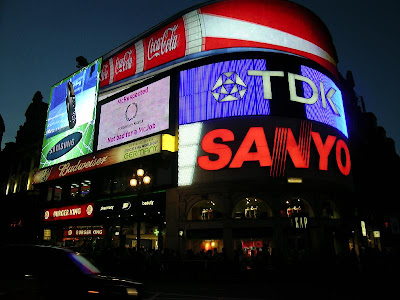 Picadilly Circus
Picadilly Circus Times Square
Times SquareAs Tore Slattaa writes, "[recent urban screen architecture] ...is analysed as reflecting shifting corporate and cultural ideas about the relations between media and society: a new material and symbolic relation between constructed spaces for symbolic creativity in the global audio visual industry and global urban centres."
She identifies the use of digital screens in the Danmarks Radio (DR) building, a national public broadcasting institution in Copenhagen. In particular, of this very large scale development, the concert hall, a design competition won by French architects Atelier Jean Nouvel.
 "Building in emerging neighborhoods is a risk that has often proved fatal in recent years. When there is no built environment upon which to found our work...we have to turn the question around: what qualities can we bring to this future? We can respond positively to an uncertainty by using its most positive attribute, that is, mystery. Mystery is never far from seduction. When the surroundings are too neutral we must create a transition, a distance between them, and us, not as a retreat into ourselves, but as a means to establish conditions that will allow a particular territory to blossom. In other words we need to bring value to the context, whatever it may be. For this we must establish a presence, an identity. I propose to materialise the context by creating an exceptional urban building respecting the planned layout of the site. It will be a volume, a mysterious parallelepiped that changes under the light of day and night whose interior can only be guessed at. At night the volume will come alive with images, colors, and lights expressing the life going on inside. The interior is a world in itself, complex and diversified..." (Jean Nouvel)
"Building in emerging neighborhoods is a risk that has often proved fatal in recent years. When there is no built environment upon which to found our work...we have to turn the question around: what qualities can we bring to this future? We can respond positively to an uncertainty by using its most positive attribute, that is, mystery. Mystery is never far from seduction. When the surroundings are too neutral we must create a transition, a distance between them, and us, not as a retreat into ourselves, but as a means to establish conditions that will allow a particular territory to blossom. In other words we need to bring value to the context, whatever it may be. For this we must establish a presence, an identity. I propose to materialise the context by creating an exceptional urban building respecting the planned layout of the site. It will be a volume, a mysterious parallelepiped that changes under the light of day and night whose interior can only be guessed at. At night the volume will come alive with images, colors, and lights expressing the life going on inside. The interior is a world in itself, complex and diversified..." (Jean Nouvel) Perhaps most compelling about the digital screen in this architecture is that is no longer a visual tool that we simply observe once or twice, but rather it is fully inhabited. The people moving around heighten the visual seduction and the changing projected images provide a complex narrative to the building's use.
Perhaps most compelling about the digital screen in this architecture is that is no longer a visual tool that we simply observe once or twice, but rather it is fully inhabited. The people moving around heighten the visual seduction and the changing projected images provide a complex narrative to the building's use.
No comments:
Post a Comment